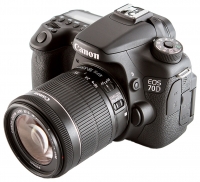Our first Canon 70D video tests show the DSLR’s Dual Pixel CMOS AF truly is a ‘game changer’
posted Thursday, August 8, 2013 at 9:40 AM EDT

Our testing of the revolutionary Canon 70D DSLR continues here at Imaging Resource. We recently posted First Shots that showcased the still image quality of Canon's hot, new APS-C model. This time around we're taking a closer look at Canon's "game changing" Dual Pixel CMOS AF system, which aims to provide vastly improved autofocus performance not only for Live View still photography, but also for video recording. The new AF system, which uses on-chip phase-detect, is touted as providing much quicker, smoother and more accurate AF performance for video recording without the jittery back-and-forth hunting of regular contrast-detect autofocus.
We pitted the 70D against its closest APS-C DSLR rival, the Nikon D7100, as well as another Canon DSLR which features the still-new Hybrid CMOS II AF system, the Canon Rebel SL1. The SL1's Hybrid CMOS II system also features sensor-embedded phase-detection AF with the same coverage area as the 70D. The SL1, however, uses its on-chip phase-detection only to get in the ballpark, then fine-tunes with contrast-detection. (Thanks to Canon for clarifying the similarities and differences between the 70D and SL1!)
In our quick comparison tests, we shot a series of videos comparing the three cameras in daylight and low light, as well as how well they handled racking focus from near to far subjects. The results? Well, consider us thoroughly impressed with the Canon 70D's video and autofocusing capabilities. See below for yourself.
*Please note that our Canon 70D is considered to be a beta sample, and there could possibly be tweaks to the camera's imaging and video capabilities between now and when the production models hit store shelves next month.
In the first test, we shot in bright sunlight, and tried to show how each camera handled AF subject tracking on a moving target.
As you can see in the video above, the Canon 70D did a pretty stellar job of keeping our subject in focus, without any of the back-and-forth focus hunting "wiggle" that we see with cameras relying solely on contrast detection. There was quite a stark difference when we shot the same subject with the Nikon D7100: It really needed to hunt around to determine focus. We had all three cameras set to facial recognition tracking, and both the D7100 and 70D took a similar length of time to recognize the subject's face, but the D7100 had trouble maintaining focus on the subject as he moved toward the camera.
Finally, the SL1 behaved similarly to the 70D for the most part, but there's a hint of AF hunting as the contrast-detect system acquires focus, and it was slower to lock onto the subject's face. The SL1 also had issues refocusing once the subject it had been tracking moved out the frame, even when we shot a second take.
With our low-light test, we initially tried a similar moving subject test, but noticed that the D7100 was having issues autofocusing at all -- even on a stationary subject. Instead we switched to a simpler test of focusing the cameras on a far subject, then introducing a foreground subject with a short distance of movement. We used FlexiZone - Single (with Movie Servo AF enabled, of course) on the two Canons and AF-F Normal on the Nikon.
The Canon 70D did brilliantly, quickly and easily refocusing to the foreground subject, and adjusting focus on the fly as he moved closer to the camera. The SL1 also did a great job, but there's a hint of AF hunting as the contrast-detect system acquires focus. The D7100, strangely, couldn't focus at all on the foreground subject. We're not sure why exactly. (And yes, we checked -- autofocus was enabled on the lens!)
In our third comparison test, we simply demonstrated how the cameras can change autofocus from near to far subjects. The Canon 70D was very smooth, accurate and acquired focus almost instantly. It's very much like a camcorder, just as Canon claimed. The SL1 also did a great job, but the speed at which it focused fluctuated. On one pass it looked very much like the 70D, but on another it was slower to nail focus. The D7100, finally, hunted back and forth quite a bit.
This test makes differences in AF noise particularly noticeable. The STM kit lenses on the 70D and SL1 (both use the EF-S 18-55mm f/3.5-5.6 IS STM lens) were near-silent. Perhaps in the quietest of rooms, one could make out some AF noise if you put your ear right next to the lens. On the other hand, the Nikon AF-S 18-105mm f/3.5-5.6G ED VR DX lens included with the D7100 was much noisier, and very audible in the recorded video using the built-in mics -- even outside among loud cicadas, and with airplanes flying overhead.
This last video is a simple demonstration of the touch-focus ability of the Canon 70D. Canon touted this feature in its "Homemade" launch video, which we featured in our first impressions Canon 70D review, and we thought we'd give it a go. Touchscreen operation -- much like we found on the SL1 and EOS M -- is very nice, and using FlexiZone - Single AF and the touchscreen to quickly and easily rack focus is a breeze.
Overall, we're very excited about the Canon 70D's new Dual Pixel CMOS AF system, especially for video recording. The camera does indeed bring camcorder-like autofocus to the DSLR arena. With the Canon 70D's fast and accurate, full-time autofocus, intelligent subject tracking, low-light AF, and a great touch-to-focus system, serious filmmakers and consumer shooters alike will no doubt welcome its significant technological advancement.